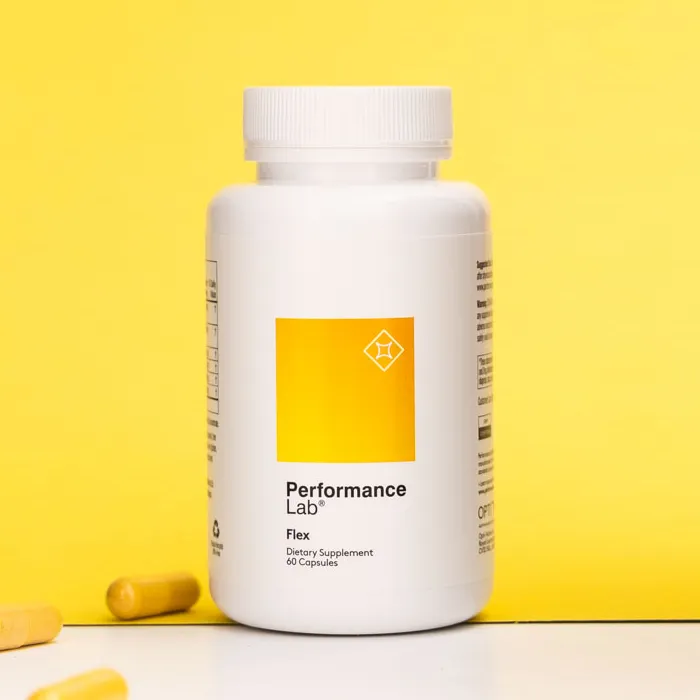Chondroitin is an essential compound found in cartilage that’s involved in helping rebuild cartilage naturally and supporting tissue recovery after injury or exercise. But for plant-based eaters looking to support their joints, there’s a new kid in town: meet phytodroitin, the vegan-friendly alternative with all the same benefits.
For anyone looking to care for their joints long-term and avoid problems that come with age, chondroitin is one of the most sought-after joint-supporting supplements on the market.
As one of the cartilage’s most important structural components and a critical part of joint strength and integrity, chondroitin is a solid pick to minimize wear and tear resulting from aging and overuse.
But because most chondroitin dietary supplements are animal-derived, they’re unsuitable for vegans.
If you want to support joint health without compromising your ethics, we have what you’re looking for—Phytodroitin™, a 100% plant-origin alternative to chondroitin supplements.
Let’s dive into the details!
Key Takeaways
- Chondroitin is a key structural component of cartilage that helps cushion joints, retain moisture, and support connective tissue repair.
- Most traditional chondroitin supplements are animal-derived, which makes them unsuitable for vegans and many ethically minded consumers.
- Phytodroitin™ is a plant-based alternative designed to closely mimic the structure and joint-supporting effects of chondroitin without animal ingredients.
- When combined with complementary ingredients like glucosamine, MSM, and anti-inflammatory botanicals, phytodroitin can help soothe joint discomfort and support long-term mobility.

What is Chondroitin and How Does It Work?
Before we get into the details of why supplementation is essential, let’s look at the basics of joint health and the role of chondroitin.
In technical terms, chondroitin sulfate is a sulfated glycosaminoglycan (GAG) comprised of a chain of alternating sugars—N-acetylgalactosamine and glucuronic acid.
More simply, chondroitin is a natural compound found in the body that’s a significant component of extracellular tissues like cartilage, bone, skin, ligaments, and tendons and is commonly used to treat arthritis 1.
In supplemental form, chondroitin is generally derived from the cartilage of animals, such as cows, pigs, or sharks, making it unsuitable for vegans and vegetarians.
The most common form of chondroitin you’ll see in supplements is chondroitin sulfate, which is combined with mineral salts to improve absorption.
Whether synthetic or natural, chondroitin is used to help build and maintain the health and integrity of connective tissues in the body.
Because it holds onto water, it’s effective for lubricating and increasing flexibility to stiff or damaged tissues and joints.
How Chondroitin Works
Chondroitin is one of the primary constituents of the human extracellular matrix (ECM), which is part of all tissues—it provides the physical “scaffolding” that holds tissues together. The extracellular matrix comprises water, proteins, and polysaccharides 2.
Chondroitin helps link the proteins and sugar molecules essential for maintaining the structural integrity of body tissues.
But its primary mechanism of action is to stimulate cartilage regeneration, which cushion the bones’ ends within joints to prevent wear and tear and friction.
And because chondroitin is technically a carbohydrate, it has water-absorbing abilities that help lubricate joint capsules and avoid rubbing bones.
But it’s not just crucial for joints—chondroitin is also essential to forming tissues elsewhere in the body, such as the skin, GI tract, and brain.
In the brain, chondroitin is part of the ECM, constituting an essential component of proteoglycans (PGs). The brain’s extracellular matrix is critical for regulating synaptic function and plasticity 3.
Chondroitin vs. Phytodroitin
Now that you understand a bit about chondroitin and why it’s important, what’s this you hear about a vegan alternative?
You read that right.
Phytodroitin™ is the latest nutrition innovation and bone and joint health that offers all of the same benefits of chondroitin, veganized. It’s a plant-based alternative to chondroitin that offers the same structure and effects, making it a 100% non-animal alternative.
Let’s summarize that:
- Chondroitin: animal-derived
- Phytodroitin: plant-derived
The effects? Equally as powerful—minus the guilt.
Health Benefits of Chondroitin Supplements
Unfortunately, you’re out of luck if you want phytodroitin from food sources.
But if you can knock back a supplement and achieve the same benefits, why wouldn’t you? Here are three big benefits of chondroitin supplements.
May help treat joint pain associated with osteoarthritis
Osteoarthritis (OA) is the most common joint disease in the United States, with approximately 10% of men and 13% of women over 60 experiencing symptomatic knee osteoarthritis 4.
The high prevalence of OA is likely due to the increasing age of the population and the obesity epidemic. But the origins of OA aren’t singular—it’s a multifactorial disease that develops from various systemic and local factors.
Age, gender, body weight, injury, repetitive use, bone density, muscle strength (or weakness), and laxity are all involved in the pathogenesis of osteoarthritis and OA pain, especially in weight-bearing joints.
While there may be lifestyle factors you can change to reduce the risk or severity of osteoarthritis, taking chondroitin might effectively mitigate the risk and reduce symptoms.
Although studies show conflicting results, they show a trend towards modest improvements in joint pain with use for several months.
However, some people experience greater benefits more quickly—especially when taking other dietary supplements and making lifestyle changes conducive to reducing symptoms.
A 2001 study published in the Journal of Rheumatology found that 1 gram/day of chondroitin sulfate showed good tolerability and reduced pain after three months of treatment. The effects persisted one-month post-treatment 5.
Another study found that oral chondroitin is more effective than a placebo for relieving pain and improving physical function in people with hip or knee osteoarthritis 6.
While there’s a fair bit of research on the efficacy of chondroitin supplements for arthritis and joint pain, the University of Utah’s School of Medicine boasts the largest-ever clinical study investigating the effects of taking glucosamine and chondroitin—it’s called “The Glucosamine/Chondroitin Arthritis Intervention Trial (GAIT)” 7.
This study compared the effects of glucosamine-chondroitin combination and alone to the effects of a placebo and a prescription drug on osteoarthritis pain for six months.
Results showed that participants with moderate to severe pain found significant relief with combined glucosamine and chondroitin sulfate supplementation—roughly 79% of participants experienced a 20% or greater reduction in pain versus just 54% for the placebo group.
Chondroitin and glucosamine also worked more than the prescription, offering more significant pain relief.
There’s a large body of evidence looking at the effects of chondroitin and joint pain, most of which points to a positive outcome, a reduction in pain, and improved physical function.
Promotes injury and exercise recovery
Training is hard on the body, and your ability to recover decreases with age. Even for people with arthritis, adding chondroitin to your supplement stack could help protect and preserve cartilage, which contributes to less pain and better physical.
Some research shows that it can help reduce joint stress after exercise or injury by supporting the production of new cartilage, keeping joints flexible, and regulating the body’s inflammatory responses.
A 2018 study found that oral supplementation with chondroitin sulfate and glucosamine (combined) led to increased chondroitin deposition in the injured area, but it also improved muscle force and stimulated the growth of regenerating muscle fibers 8.
Researchers suggest that these effects may be due to increased muscle cell proliferation and blocking of NF-kB nuclear translocation and TNFa production.
Research isn’t as strong in this area, so further studies are needed to confirm these effects.
Accelerates wound healing and improves skin health
Chondroitin and glucosamine sulfate are fantastic supplements for healing wounds, skin inflammation, and other skin-related issues.
For people with severe injuries or burns, chondroitin and glucosamine are often used for treatment to maintain moisture and accelerate healing 9.
Some research even finds that burn victims requiring skin grafting may benefit from chondroitin to speed up healing time and regulate levels of inflammation.
You may also see chondroitin combined with hyaluronic acid (HA), which is found in the skin, eye sockets, bones, connective tissue, joints, tendons, and cartilage; hyaline cartilage is a specific type of cartilage that covers the end of bones to provide cushioning and prevent friction. It lubricates joints and naturally increases moisture, elasticity, and flexibility 10.
How to Heal and Protect Your Joints
If you’re looking to protect your joints, there is no shortage of supplements on the market—but if you want one that’s effective, ensure it has Phytodroitin™ or chondroitin, like Performance Lab® Flex.

Flex is an upgraded joint supplement designed to soothe and protect active joints for optimal lifelong performance.
Flex leverages the power of easy-on-the-stomach botanicals AprèsFlex® Boswellia serrata and CurcuWIN® curcumin to reduce pain and lubricates and nourishes joints with Phytodroitin™, OptiMSM®, and corn glucosamine—all in vegan-friendly forms.
Flex supplies 100% clean, natural joint relief with advanced-form nutrients for optimal absorption and effectiveness, targeting peak flexibility, resilience, and comfort across all activities.
Although there isn’t a daily recommended intake for chondroitin or glucosamine sulfate, we can take some information from the GAIT study, which uses glucosamine and chondroitin in the following dosages:
- Glucosamine (alone): 1,500 mg daily, separated into 500 mg three times a day.
- Chondroitin sulfate (alone): 1,200 mg daily, taken as 400 mg three times a day.
- Glucosamine + chondroitin sulfate (combined): Same doses as above
References
- Henrotin Y, Mathy M, Sanchez C, Lambert C. Chondroitin sulfate in the treatment of osteoarthritis: from in vitro studies to clinical recommendations. Ther Adv Musculoskelet Dis. 2010;2(6):335-348.
- Frantz C, Stewart KM, Weaver VM. The extracellular matrix at a glance. J Cell Sci. 2010;123(Pt 24):4195-4200.
- Frischknecht R, Gundelfinger ED. The brain’s extracellular matrix and its role in synaptic plasticity. Adv Exp Med Biol. 2012;970:153-171.
- Zhang Y, Jordan JM. Epidemiology of osteoarthritis (published correction appears in Clin Geriatr Med. 2013 May;29(2):ix). Clin Geriatr Med. 2010;26(3):355-369.
- Mazieres B, Combe B, Phan Van A, Tondut J, Grynfeltt M. Chondroitin sulfate in osteoarthritis of the knee: a prospective, double blind, placebo controlled multicenter clinical study. J Rheumatol. 2001;28(1):173-181.
- Zhu X, Sang L, Wu D, Rong J, Jiang L. Effectiveness and safety of glucosamine and chondroitin for the treatment of osteoarthritis: a meta-analysis of randomized controlled trials. J Orthop Surg Res. 2018;13(1):170.
- National Center for Complimentary and Alternative Medicine. The NIH Glucosamine/Chondroitin Arthritis Intervention Trial (GAIT). J Pain Palliat Care Pharmacother. 2008;22(1):39-43.
- Montell E, Contreras-Muñoz P, Torrent A, de la Varga M, Rodas G, Marotta M. Mechanisms of action of chondroitin sulfate and glucosamine in muscle tissue: in vitro and in vivo results. A new potential treatment for muscle injuries? Osteoarthritis and Cartilage. 2018;1(26):S404.
- Wang TW, Sun JS, Wu HC, Tsuang YH, Wang WH, Lin FH. The effect of gelatin-chondroitin sulfate-hyaluronic acid skin substitute on wound healing in SCID mice. Biomaterials. 2006;27(33):5689-5697.
- Gupta RC, Lall R, Srivastava A, Sinha A. Hyaluronic Acid: Molecular Mechanisms and Therapeutic Trajectory. Front Vet Sci. 2019;6:192.
















